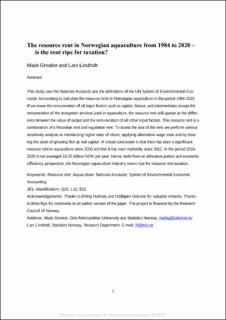The Resource Rent in Norwegian Aquaculture from 1984 to 2020 – Is the Rent Ripe for Taxation?
Journal article
Published version

View/
Date
2022Metadata
Show full item recordCollections
- Artikler / Journal articles [426]
- Publikasjoner fra Cristin [138]
Abstract
This study uses the National Accounts and the definitions of the UN System of Environmental-Economic Accounting to calculate the resource rents in Norwegian aquaculture in the period 1984-2020. If we know the remuneration of all input factors such as capital, labour, and inter-mediates except the remuneration of the ecosystem services used in aquaculture, the resource rent will appear as the difference between the value of output and the remuneration of all other input factors. This resource rent is a combination of a Ricardian rent and regulation rent. To as-sess the size of the rent, we perform various sensitivity analysis as introducing higher rates of return, applying alternative wage costs and by treating the stock of growing fish as real capital. A robust conclusion is that there has been a significant resource rent in aquaculture since 2000 and that it has risen markedly since 2012. In the period 2016-2020 it has averaged 18-20 billion NOK per year. Hence, both from an allocative justice and economic efficiency perspective, the Norwegian aquaculture industry seems ripe for resource rent taxation.